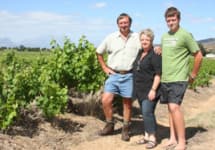Alheit La Colline Semillon 2017
- Vinous
-
Wine &
Spirits -
Robert
Parker -
Wine
Spectator



Product Details
Your Rating
Somm Note
Winemaker Notes
The La Colline vineyard is uniquely South African in that dark skinned Semillon vines are inter-planted with light skinned Semillon. It was planted 82 yrs ago on the southern slope of Dassenberg in Franschhoek on soils of decomposed granite with quartz, and 310–350m above sea-level. In summer, the tightly-planted bushvines form a wild looking mess. In winter they resemble a crowd of drunkards cart wheeling across the slope. The vines are very settled, producing a wine of remarkable depth and mouthfeel.
Professional Ratings
-
Vinous
The 2017 La Colline Vineyard comes from vines planted in 1936 from original genetic material bought to the Cape in the 1600s. Pure Sémillon Gris, it was matured in fifth-fill barrels. It has a very precise bouquet, perhaps the most mineral-driven of all Chris Alheit’s 2017s, featuring hints of apricot blossom, Turkish delight and a very subtle petrol note. The palate is extremely well balanced, smooth and poised in the mouth, displaying a slight waxy texture and perfect acidity. Veins of ginger and lemongrass appear toward the persistent finish.
-
Wine & Spirits
Under a wax seal, the 2017 La Colline Vineyard is slightly reductive, but once you get the glass spinning, the wine reveals oak aromas of toasted brioche and vanilla seamlessly integrated into the Semillon, along with a waxy pomaceous fruit. This is really thoughtful winemaking here. Flavors of apples and lemons are beautifully balanced by the oak treatment and subtle, fine minerality that combine to extend texture across the mid-palate. If you are a Burgundy lover and looking from something familiar yet different, check this out. It has a delicate yet structured finesse, with a complex power to the mouthfeel and is medium to full-bodied with a long, richly textured finish.
-
Robert Parker's Wine Advocate
Under a wax seal, the 2017 La Colline Vineyard is slightly reductive, but once you get the glass spinning, the wine reveals oak aromas of toasted brioche and vanilla seamlessly integrated into the Semillon, along with a waxy pomaceous fruit. This is really thoughtful winemaking here. Flavors of apples and lemons are beautifully balanced by the oak treatment and subtle, fine minerality that combine to extend texture across the mid-palate. If you are a Burgundy lover and looking from something familiar yet different, check this out. It has a delicate yet structured finesse, with a complex power to the mouthfeel and is medium to full-bodied with a long, richly textured finish.
-
Wine Spectator
Intense nectarine, tangerine and peach flavors form the majority of the core in this white, while flashes of mirabelle plum, quinine and green fig check in. Has ripeness and depth, but a racy feel stays buried on the finish, adding latent energy. Should be fun to cellar. Sémillon.



Sémillon has the power to create wines with considerable structure, depth and length that will improve for several decades. It is the perfect partner to the vivdly aromatic Sauvignon Blanc. Sémillon especially shines in the Bordeaux region of Sauternes, which produces some of the world’s greatest sweet wines. Somm Secret—Sémillon was so common in South Africa in the 1820s, covering 93% of the country’s vineyard area, it was simply referred to as Wyndruif, or “wine grape.”

With an important wine renaissance in full swing, impressive red and white bargains abound in South Africa. The country has a particularly long and rich history with winemaking, especially considering its status as part of the “New World.” In the mid-17th century, the lusciously sweet dessert wines of Constantia were highly prized by the European aristocracy. Since then, the South African wine industry has experienced some setbacks due to the phylloxera infestation of the late 1800s and political difficulties throughout the following century.
Today, however, South Africa is increasingly responsible for high-demand, high-quality wines—a blessing to put the country back on the international wine map. Wine production is mainly situated around Cape Town, where the climate is generally warm to hot. But the Benguela Current from Antarctica provides brisk ocean breezes necessary for steady ripening of grapes. Similarly, cooler, high-elevation vineyard sites throughout South Africa offer similar, favorable growing conditions.
South Africa’s wine zones are divided into region, then smaller districts and finally wards, but the country’s wine styles are differentiated more by grape variety than by region. Pinotage, a cross between Pinot Noir and Cinsault, is the country’s “signature” grape, responsible for red-fruit-driven, spicy, earthy reds. When Pinotage is blended with other red varieties, like Cabernet Sauvignon, Merlot, Syrah or Pinot Noir (all commonly vinified alone as well), it is often labeled as a “Cape Blend.” Chenin Blanc (locally known as “Steen”) dominates white wine production, with Chardonnay and Sauvignon Blanc following close behind.
